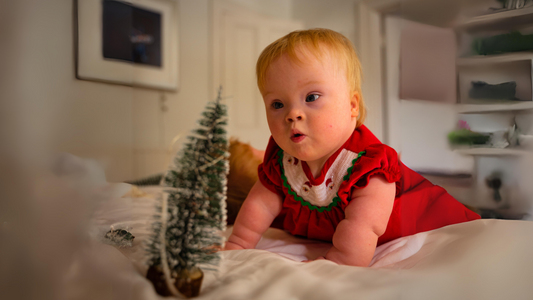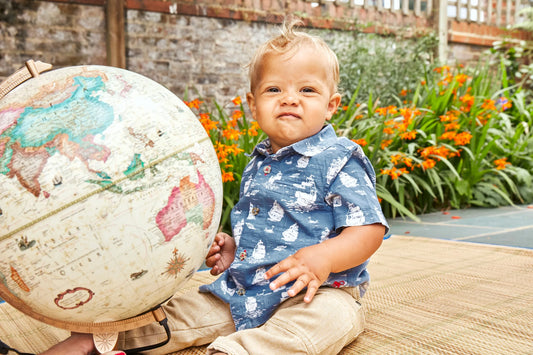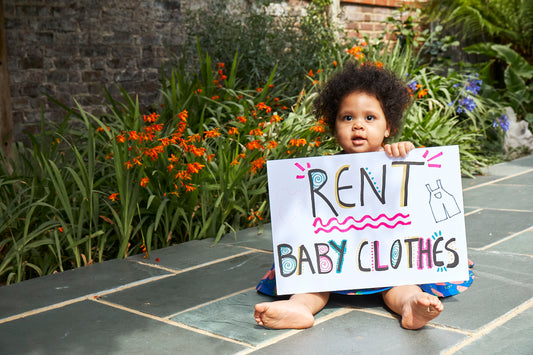Babies grow sooo fast, shooting through clothing sizes faster than you can blink! But what can you do with all those outgrown clothes piling up in your wardrobe? Can you recycle baby clothes?
This World Recycling Day, we looked into textile recycling and whether this could be the answer to your overflowing cupboards!
What is Recycling?
It seems like a simple question, but what actually happens to our recycling after it’s collected?
Recycling breaks down and converts waste materials into new materials and objects. Ideally recycling a material produces fresh supplies of the same material - eg office paper to office paper, polystyrene is reformed into cups and metal cans, glass or plastic bottles are cleaned, broken down and remade.
People often see recycling as being synonymous with ‘eco-friendly’ but unfortunately it is not as simple as that. The 3 R’s of sustainability are Reduce, Re-use, Recycle. These terms describe ways for us to minimise the need for new materials and Earth’s resources to produce ‘stuff’, as well as all the energy used and waste created in the production process. It’s easy to forget about the first to R’s and skip straight to recycling. Recycling should really be the last-resort final step in your sustainability cycle!
How did it all start?

Recycling (including up- and down-cycling) in the UK started in the early 1800’s with rag and bone men who collected unwanted household items and sold them to merchants. The merchants turned scraps of cloth and paper into cardboard, melted down and reformed broken glass, made bones into toys, knife handles and soap and even skinned cats and dogs to make clothes! In Yorkshire, rag & bone men would collect waste wool and rags to be made into a woolen textile or yarn called shoddy. Workers would separate any surplus seams and unusable parts and turn them into bedding or stuffing or rot them down as farm manure.
Later in the 1900’s, recycling re-emerged. Citizens kept tin cans, cloth, cooking oils and fats to help with the war effort. By the 1970’s consumption had grown to unsustainable levels and landfills had begun to overflow. This led environmentalists and local councils to set up home and curb-side recycling to help start off the sorting process.
Sustainable Textile Recycling
Closed Loop textile recycling is the holy grail - we’re not there yet, but we’re getting close. Closed Loop design and manufacturing processes use materials again and again to keep materials on the production line and out of landfills. Some examples of closed-loop in fashion manufacture include the development work by companies such as Evrnu, Worn Again Technologies, Renewcell, RubyMoon and I:CO who turn clothing that would otherwise be thrown away into ‘new’ yarn and textiles.
Scientists are developing new sustainable textiles, for example, Tencel. This fiber is created from the pulp of sustainably grown eucalyptus trees. The manufacturing process uses a no-waste production method powered by renewable energy. The solvents and liquids needed for production are recovered and reused.
If you are buying baby clothing new, support the right brands! Buy from brands that use sustainable materials that are hard wearing and easy to re-purpose. There are lots of great brands out there leading the way in trying new materials that are healthier for the planet and your baby's sensitive skin. This includes our Return & Earn partner brands who you can check out here.
Closed Loop or Open Loop, all these recycling processes still require time, energy and cost. The ideal way to reduce your negative impact on the planet is to refuse to buy things you don’t actually need, to buy well and where possible to share and re-use what you have. You can always look for ways to re-use or repair an item before you need to recycle.
Can I Recycle Baby Clothes?

To genuinely recycle we need to purchase items made from recycled materials, recycle those items and repeat. If you dress your baby in 100% cotton or are a stickler for merino wool, in theory, it should be possible to recycle your baby’s old clothes over and over again.
It’s difficult to separate mixed materials and components. This makes it hard to recycle most fashion and baby items which are often made from mixed fibers and have lots of poppers and zip fastenings. Recycling companies like those mentioned earlier can easily sort and shred natural fibers such as cotton and wool to make it into a cleaned, respun fine yarn. They can also shred synthetic materials like polyester, nylon and other petroleum-based fabrics into granulated chips and process these to create new fibers.
When the baby clothes in our SuperLooper library are really past their best we send them to SOEX . They do their recycling alchemy, turning textiles into flooring, insulation and even pencils. Also, this summer we’re launching our LoopUP up-cycling project - watch this space!
SuperLoopers Reduce and Re-use!
Every kilogram of textiles produced generates about 17 kilograms of CO2. There are already apparently enough clothes in existence to clothe the next 6 generations! The best way to reduce the environmental impact of baby clothes is to buy (or rent!) preloved. Let's use the items that are already in existence! Continuing to actively wear a garment for just 9 months longer will significantly reduce environmental carbon, water and waste footprints!
As a SuperLooper you’re taking action to support the first 2 R’s when it comes to reducing textile waste - yes, go on, give yourself a pat on the back! Reduce and Reuse are the best ways to care for our planet. Reduce what you consume in the first place (collect memories, not things) and re-use what you have for as long as possible.
All the clothes in our library are pre-loved and have been looped by parents and brands doing a conscious clear-out of their cupboards so that we can offer their outgrown or surplus clothes for you to enjoy.
Recycling baby clothes is vastly better than sending them to landfill but if you’re SuperLooping, please keep on doing what you do to reduce and reuse. Part of the joy of looping is the positive environmental impact that we have by sharing what’s out there already!
Click here to find out more about baby clothing rental.



